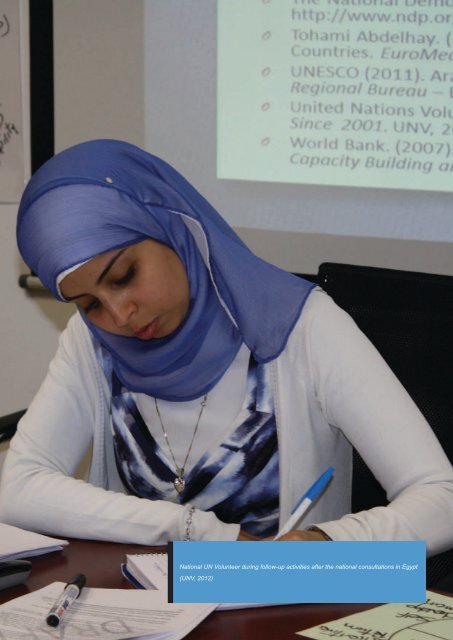J7rQWv
J7rQWv
J7rQWv
You also want an ePaper? Increase the reach of your titles
YUMPU automatically turns print PDFs into web optimized ePapers that Google loves.
Chapter One Egypt<br />
UNV Findings Report<br />
National UN Volunteer during follow-up activities after the national consultations in Egypt<br />
(UNV, 2012)<br />
According to the Egypt Human Development Report (2010) 8 , the youth bulge first appeared in<br />
1995 and is expected to last until 2045. Those young men and women fall within the 18 to 29<br />
age group, an estimated 23.5% of the total population in 2010, or 19.8 million individuals. Prior<br />
to the January 25 Revolution, with youth facing high rates of unemployment, limited job security<br />
and stability, and with a majority of new entrants finding employment within the informal economy<br />
(Assaad 5) 9 , those numbers were mostly addressed as a problem and a serious hindrance to<br />
development. It was only with the advent of the Arab Awakening, and what became known as<br />
a “youth quake”, that an asset-based approach and a shift from “problem” to “opportunity” were<br />
adopted regarding youth.<br />
It is important, however, to look at those shifts within context and as part of a continuum. The<br />
Population Council’s Survey on Young People in Egypt (SYPE) 10 in 2009, which covered a<br />
nationally-representative sample of 15,029 young people (ages 10-29), concluded that young<br />
people in Egypt are disengaged and that only 2% of the youth population participate in volunteer<br />
work. This stands in contrast to the unprecedented citizen engagement by youth during and<br />
following the January 25 Revolution and to a gradual shift in the definition of volunteerism that<br />
had been taking place in the period leading up to it, which points to a gap in our understanding<br />
of volunteerism in Egypt. Hesham El Rouby, Chairman of Etijah and Youth Association for<br />
Population and Development Civil Society Organizations (CSOs) reflects on shifts in the<br />
discourse and relates that in the last ten years:<br />
There has been progress in public understanding of volunteerism, the word volunteerism<br />
in Egypt used to mean either volunteering in the military or to volunteer donations. It<br />
was also more attributed towards work done by females rather than males, since there<br />
had been a cultural understanding that girls were more likely to volunteer with time and<br />
effort compared to boys. But I see now advancements in its definition as it has become<br />
associated with development, because volunteer work adds great personal benefit to the<br />
volunteer, including ideas, skills, and expertise.<br />
The opportunities and motivations for volunteerism have been directly impacted by shifts in<br />
the socio-political and economic environment and became the locale in which those shifts<br />
have become visible. With a changing space for activism, volunteerism became an outlet for<br />
young undergraduates and/or university graduates to develop their skills and engage in various<br />
community activities. For women, it has become a way to socialize and to escape the strictures<br />
of traditions that confined them to their homes. The religious discourse is also prevalent in<br />
volunteerism. In a study conducted by Barbara Ibrahim and Leah Hunt Hendrix (2011) 11 , they<br />
underscore how young volunteers in Resala, an NGO with around 100,000 volunteers in all 29<br />
governorates in Egypt, “framed” their activities within a religious language (16). In post-January<br />
25, nationalistic sentiments were brought to the foreground as one of the primary motivations of<br />
volunteerism, adding a new layer to our understanding of youth engagement.<br />
Furthermore, a better understanding of the environment and dynamics of volunteerism in Egypt<br />
can be approached at three levels; enabling environment (policy and culture), institutional and<br />
individual. Regarding policy, the UN Youth Report (August 2010-2011) concludes that youth in<br />
8 Complete report is available.<br />
9 Assaad, Ragui and Ghada Barsoum. “Youth Exclusion in Egypt: In Search of Second Chances.” Middle East<br />
Youth Initiative Working Papers, 2007.<br />
10 Complete report is available.<br />
11 Ibrahim, Barbara and Leah Hunt-Hendrix. “Youth, Service and Pathways to Democracy in Egypt.” Voices on<br />
Arab Philanthropy and Civic Engagement. Cairo: John D. Gerhart Center for Philanthropy and Civic Engage<br />
ment, 2011. :<br />
Egypt 6


